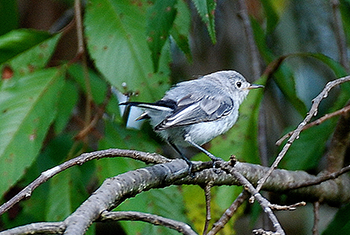
By Terry W. Johnson
Each spring and fall, many birds pass through Georgia flying to and from their breeding grounds. In the spring, some of these migrants remain to raise their young. Most Georgians are familiar with some of these birds, such as the summer tanager, purple martin, ruby-throated hummingbird and gray catbird.
Yet while the blue-gray gnatcatcher is also a summer resident throughout the entire state, most people rarely see one. And if they do, many do not recognize it.
One reason blue-gray gnatcatchers are so difficult to see is they are among our smallest birds, only 3.9 to 4.3 inches long and with a wingspan of just 4.3 inches. They weigh only about a quarter of an ounce, or roughly the weight of a nickel.
In addition, plumage of blue-gray gnatcatchers can be best described as muted. Some people say they remind them of miniature mockingbirds. Their plumage is blue-gray with the exception of the bird’s underside, which is grayish-white. The tails feature white outer feathers.
The blue-gray catcher’s eyes are encircled with a white ring. The top of its head is dark blue. The male has a black “V” that extends from the base of the bill to above its eyes.
Another reason identifying this sprite of a bird is so difficult is its behavior: Blue-gray gnatcatchers are seemingly always moving rapidly about searching for food. Consequently, if you encounter the bird, more often than not, you only catch a glimpse of it before it disappears into the foliage.
One of the best times of the year to see a blue-gray gnatcatcher is in early spring before the leaves of many shrubs and trees have fully emerged. I am sure that is one of the reasons why I had the good fortune of seeing my first blue-gray gnatcatcher of the year in late March. I was alerted to the bird’s presence by its thin nasal tzyzee call. I immediately stopped, looked up and spotted the bird hopping about on the leafless limbs of a black walnut tree.
The blue-gray gnatcatcher has an extensive repertoire of songs. However, it takes somebody with great hearing to detect them. The bird’s song list includes snatches of the songs of many of its feathered neighbors, such as the rufous-sided towhee, blue jay, warblers and vireos. You can listen to many of these vocalizations online at the Cornell Laboratory of Ornithology’s website.
Male and female blue-gray gnatcatchers mate for life (about four years). The birds nest twice annually. The male attracts his mate to potential nesting locations with his songs. Once a site – often in an oak tree growing near water – is selected, the pair shares the task of constructing a nest.
Nests are built anywhere from 12-40 feet above the ground. Gnatcatchers often nest in old nest sites, and will even reconstruct an old nest instead of building another. Nests will be on the outer reaches of a horizontal limb or in the upright fork of a tree. Each will look much like an extremely large hummingbird nest or a knot on a tree. On several occasions when I have presented hummingbird programs, several folks have shown me what they thought were large hummingbird nests but were actually fashioned by blue-gray gnatcatchers.
The birds build the nests using a combination of twigs and grass held together with spider silk. The inner nest is lined with soft grass and animal hair. The amazing creation is then camouflaged with lichens.
The female lays four to five pale blue to bluish-white eggs before incubation commences. Both parents share incubation duties, which can last 11-15 days.
Once the eggs hatch, both parents feed the young. The young remain in the nest for another 10-15 days. Interestingly, while the female is still feeding their young, the male begins building a second nest!
Blue-gray gnatcatchers have to contend with predators that threaten their eggs as well as the nestlings. Domestic or feral cats and snakes are significant predators. Predation sometimes forces the birds to build up to 10 nests in a single nesting season.
The blue-gray gnatcatcher’s diet mainly consists of small insects and their eggs, including flies, small wasps, leafhoppers, caterpillars and spiders. Ironically, the tiny birds rarely eat gnats. They catch their prey by snatching insects out of the air, gleaning them from leaves and branches, and even pilfering spiderwebs.
The birds will often hold their tails upright while feeding. They will also rapidly flick their tails from side to side trying to flush tiny animals hiding in the foliage.
If you want to try to add the blue-gray gnatcatcher to your bird list, here are a few tips that might help. Search for the them early in the morning. This is a peak feeding time for most birds. Carry a pair of binoculars. Since these small, fast-moving birds are more likely to be seen in the tops of a tree than an azalea bush, binoculars give you the best chance of spotting them. Also, learn the blue-gray gnatcatcher’s call. Since the bird is often difficult to hear, try downloading the free Merlin bird identification app from Cornell. This amazing app will often detect bird calls and songs before you do.
Although I rarely see a blue-gray gnatcatcher in my yard, just knowing it and an untold number of other unseen animals are living in my yard makes stepping outside the door each morning an adventure. I never know what I am going to encounter.
Terry W. Johnson is a retired Nongame program manager with the Wildlife Resources Division and executive director of The Environmental Resources Network, or TERN, friends group of the division’s Nongame Conservation Section. (Permission is required to reprint this column.) Learn more about TERN, see previous “Out My Backdoor” columns, read Terry’s Backyard Wildlife Connection blog and check out his latest book, “A Journey of Discovery: Monroe County Outdoors.”



















